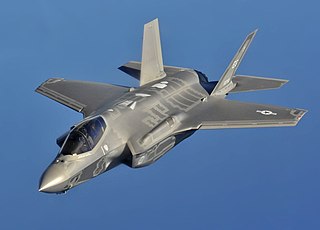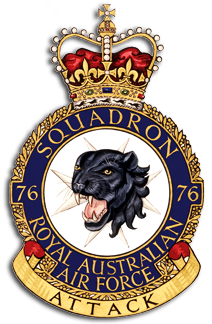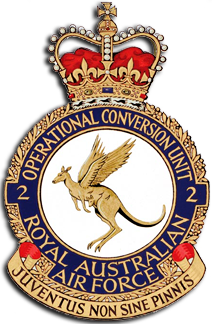
The Lockheed Martin F-35 Lightning II is an American family of single-seat, single-engine, all-weather stealth multirole combat aircraft designed for air superiority and strike missions; it also has electronic warfare and intelligence, surveillance, and reconnaissance capabilities. Lockheed Martin is the prime F-35 contractor with principal partners Northrop Grumman and BAE Systems. The aircraft has three main variants: the conventional takeoff and landing (CTOL) F-35A, the short take-off and vertical-landing (STOVL) F-35B, and the carrier-based (CV/CATOBAR) F-35C.

The Royal Australian Air Force (RAAF) is the principal aerial warfare force of Australia, a part of the Australian Defence Force (ADF) along with the Royal Australian Navy and the Australian Army. Constitutionally the Governor-General of Australia is the de jure Commander-in-Chief of the Australian Defence Force. The Royal Australian Air Force is commanded by the Chief of Air Force (CAF), who is subordinate to the Chief of the Defence Force (CDF). The CAF is also directly responsible to the Minister for Defence, with the Department of Defence administering the ADF and the Air Force.

The Boeing F/A-18E and F/A-18F Super Hornet are a series of American supersonic twin-engine, carrier-capable, multirole fighter aircraft derived from the McDonnell Douglas F/A-18 Hornet, in service with the armed forces of the U.S., Australia, and Kuwait. The F/A-18E single-seat and F/A-18F tandem-seat variants are larger and more advanced versions of the F/A-18C and D Hornet, respectively.

RAAF Base Williamtown is a Royal Australian Air Force (RAAF) military air base located 8 nautical miles north of Newcastle in the local government area of Port Stephens, in New South Wales, Australia. The base serves as the headquarters to both the Air Combat Group and the Surveillance and Response Group of the RAAF. The military base shares its runway facilities with Newcastle Airport. The nearest towns are Raymond Terrace, located 8 km (5 mi) west of the base and Medowie, 6.8 km (4.2 mi), north of the base, which is home to many of the base's staff.

No. 75 Squadron is a Royal Australian Air Force (RAAF) fighter unit based at RAAF Base Tindal in the Northern Territory. The squadron was formed in 1942 and saw extensive action in the South West Pacific theatre of World War II, operating P-40 Kittyhawks. It was disbanded in 1948, but reformed the following year and operated jet aircraft throughout the Cold War. The squadron was based at Malta from 1952 to 1954, flying de Havilland Vampires, and Malaysia from 1968 to 1983, with Dassault Mirage IIIs, before returning to Australia.

RAAF Base Tindal is a Royal Australian Air Force (RAAF) military air base and civil aviation airfield located 8 nautical miles east southeast of the town of Katherine, Northern Territory in Australia. The base is currently home to No. 75 Squadron and a number of non-flying units, and also hosts the civilian Katherine Tindal Airport. First constructed in 1942, it was refurbished in the late 1960s as a bare base capable of being utilised when required. It was opened as a permanently manned RAAF base in 1989.

No. 3 Squadron is a Royal Australian Air Force (RAAF) fighter squadron, headquartered at RAAF Base Williamtown, near Newcastle, New South Wales. Established in 1916, it was one of four combat squadrons of the Australian Flying Corps during World War I, and operated on the Western Front in France before being disbanded in 1919. It was re-established as a permanent squadron of the RAAF in 1925, and during World War II operated in the Mediterranean Theatre. The Cold War years saw the squadron disbanded and re-raised twice. It was based at RAAF Butterworth during the Malayan Emergency and the Indonesia–Malaysia Konfrontasi. Equipped with McDonnell Douglas F/A-18 Hornet multi-role fighters from 1986, the squadron deployed to Diego Garcia in 2002 to provide local air defence, and the following year contributed aircraft and crews to the invasion of Iraq as part of Operation Falconer. In April 2016, it deployed to the Middle East as part of the military intervention against ISIL. The squadron began re-equipping with Lockheed Martin F-35 Lightning II multi-role fighters in 2018.

No. 77 Squadron is a Royal Australian Air Force (RAAF) squadron headquartered at RAAF Base Williamtown, New South Wales. It is controlled by No. 81 Wing, part of Air Combat Group, and equipped with Lockheed Martin F-35 Lightning II multi-role stealth fighters.

No. 76 Squadron is a Royal Australian Air Force (RAAF) flight training squadron. Established in 1942, it operated P-40 Kittyhawk fighter aircraft in the South West Pacific theatre during World War II. Following the end of hostilities it re-equipped with P-51 Mustangs and formed part of Australia's contribution to the occupation of Japan until disbanding in 1948. The squadron was re-formed in 1949 and three years later transferred to Malta, where it operated de Havilland Vampire jet fighters on garrison duty until again disbanding in 1955. It was reactivated in 1960 and operated CAC Sabre and Dassault Mirage III fighters in Australia until 1973. No. 76 Squadron was re-formed in its present incarnation in 1989 and is currently stationed at RAAF Base Williamtown, New South Wales, where it operates Hawk 127 jet training aircraft.

No. 2 Operational Conversion Unit is a fighter training unit of the Royal Australian Air Force (RAAF). Located at RAAF Base Williamtown, New South Wales, the unit trains pilots to operate the Lockheed Martin F-35 Lightning II. Pilots new to the F-35 enter No. 2 2OCU after first qualifying to fly fast jets at No. 79 Squadron and undertaking initial fighter combat instruction at No. 76 Squadron. Once qualified on the F-35, they are posted to one of No. 81 Wing's operational F-35 units, No. 3 Squadron, No. 75 Squadron or No. 77 Squadron.

The Royal Australian Air Force's Air Combat Group (ACG) is the group which administers the RAAF's fighter and bomber aircraft. ACG was formed on 7 February 2002 by merging the RAAF's Tactical Fighter Group and Strike Reconnaissance Group in an attempt to improve the speed with which the RAAF can deploy its combat aircraft.

No. 81 Wing is responsible for operating the Lockheed Martin F-35 Lightning II multi-role fighters of the Royal Australian Air Force (RAAF). Headquartered at RAAF Base Williamtown, New South Wales, the wing comprises three combat units, Nos. 3 and 77 Squadrons based at Williamtown and No. 75 Squadron at RAAF Base Tindal, Northern Territory, as well as an operational conversion unit at Williamtown. No. 81 Wing headquarters oversees squadron training in air-to-air and air-to-ground tactics, and support for the Australian Army and Royal Australian Navy. Tasked with offensive and defensive counter-air operations, the Hornets have been deployed to Diego Garcia in 2001–02, when they provided local air defence, to Iraq in 2003, when they saw action flying fighter escort and close air support missions in concert with Coalition forces, and to the Middle East in 2015–16, when they undertook strike operations during the military intervention against ISIL. They have also been employed to patrol high-profile events in Australia, including the Commonwealth Games and visits by foreign dignitaries.

No. 82 Wing is the strike and reconnaissance wing of the Royal Australian Air Force (RAAF). It is headquartered at RAAF Base Amberley, Queensland. Coming under the control of Air Combat Group, the wing operates F/A-18F Super Hornet multirole fighters, EA-18G Growler electronic warfare aircraft, and Pilatus PC-21 forward air control aircraft. Its units include Nos. 1 and 6 Squadrons, operating the Super Hornet and Growler respectively, as well as No. 4 Squadron, operating the PC-21.

Lockheed Martin F-35 Lightning II procurement is the planned selection and purchase of the Lockheed Martin F-35 Lightning II, also known as the Joint Strike Fighter (JSF) by various countries.

The Royal Australian Air Force (RAAF) operated McDonnell Douglas F/A-18 Hornet fighter aircraft between 1984 and 2021. The Australian Government purchased 75 A and B variants of the F/A-18 in 1981 to replace the RAAF's Dassault Mirage III fighters. The Hornets entered service with the RAAF between 1984 and 1990. Four Hornets were destroyed in flying accidents during the late 1980s and early 1990s.
The F-X fighter program is a phased procurement program for fighter aircraft for the Republic of Korea Air Force. As of 2018 the air force has purchased 60 F-35 Lightning II fighters.

The Lockheed Martin F-35 Lightning II is a family of stealth multirole fighters that first entered service with the United States in 2015. The aircraft has been ordered by program partner nations, including the United Kingdom, Italy, Norway, and Australia, and also through the Department of Defense's Foreign Military Sales program, including Japan, South Korea, and Israel. The units that operate or plan on operating the aircraft are listed below.

Dassault Mirage III Australian procurement was a transaction between the French and Australian governments which led to the procurement of the French designed fixed wing jet aircraft, the Mirage III, for the Royal Australian Air Force (RAAF). In the late 1950s the Australian government announced its intention to modernize its air force with state of the art technology and the French manufacturing company Dassault won the bid over the American Lockheed when the Australian government agreed to buy over 100 Mirages at an estimated cost of AUS$193.7 million in the early 1960s.

Lockheed Martin Australia is a wholly owned subsidiary of Lockheed Martin Corporation, with 1,200 local staff. It is one of the largest suppliers of materiel, technology, services and training to the Australian Defence Force. These include guided weapons, naval aviation combat systems, combat aircraft, transport aircraft and space domain awareness.


















